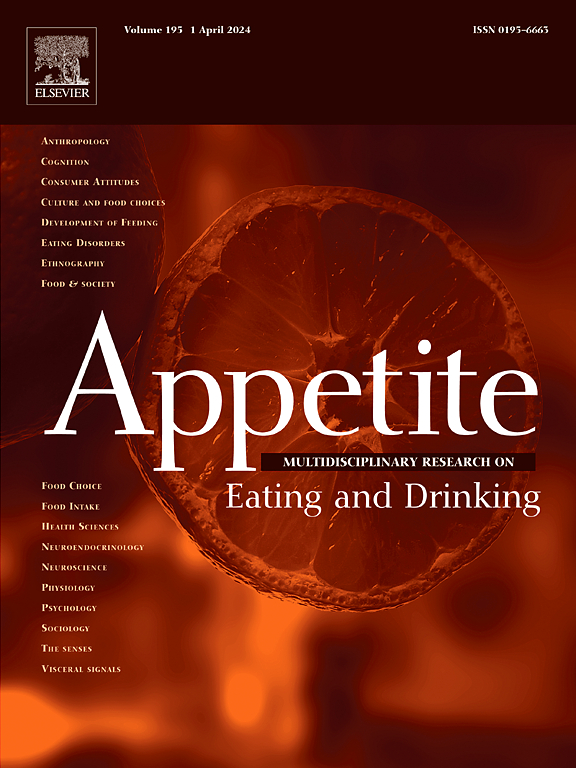Energy intake and appetite in laboratory and free-living conditions may be consistent across menstrual cycle phases
IF 3.8
2区 医学
Q1 BEHAVIORAL SCIENCES
引用次数: 0
Abstract
Background
Self-reported dietary intake varies across menstrual cycle phases, but objective assessments of dietary intake together with appetite and resting metabolic rate (RMR) are limited. This study aimed to assess differences in dietary intake, appetite, and RMR during two hormonally-distinct menstrual cycle phases in laboratory and free-living settings.
Methods
Healthy premenopausal females with predictable normal-length menstrual cycles completed two study visits: one in the late-follicular and one in the mid-luteal phase. Menstrual cycle phases were assessed using urinary luteinizing hormone surge and prospective cycle days. Participants consumed a 2-day energy- and macronutrient-balanced run-in diet prior to each visit. RMR was measured with indirect calorimetry, followed by appetite ratings before and after a standardized breakfast, and a food cravings questionnaire. Appetite was also tracked for 2.5 days post-visit in a free-living environment. Ad libitum energy and macronutrient intakes were measured using pre-weighed plus weighing of uneaten food at an in-laboratory lunch meal, as well as during the 2.5-day free-living period.
Results
Eighteen participants were included (age: 21 ± 4 years; body mass index: 21.2 ± 1.5 kg/m2). There were no differences between in-laboratory ad libitum energy or macronutrient intakes, appetite, or food cravings between phases. RMR did not differ between phases, although the mid-luteal phase RMR tended to be higher (104 ± 218 kcal/day higher; P = 0.074). No main or interaction effects for phase or time were observed for free-living dietary intake nor appetite ratings.
Conclusions
Although RMR tended to be increased during the luteal phase, comprehensive appetite and energy intake assessments showed no significant cycle-phase differences in these 18 participants.
在实验室和自由生活条件下,能量摄入和食欲可能在月经周期的各个阶段是一致的
自我报告的膳食摄入量在月经周期各阶段有所不同,但对膳食摄入量、食欲和静息代谢率(RMR)的客观评估是有限的。本研究旨在评估在实验室和自由生活环境下,在两个激素不同的月经周期阶段,饮食摄入量、食欲和RMR的差异。方法健康的绝经前女性,月经周期可预测正常长度,完成两次研究访问:一次在卵泡晚期,一次在黄体中期。使用促黄体生成素激增和预期周期来评估月经周期阶段。参与者在每次访问前消耗了两天的能量和大量营养素平衡的饮食。RMR是用间接量热法测量的,然后是标准化早餐前后的食欲评分,以及食物渴望问卷。在随访后的2.5天内,他们在自由生活的环境中对食欲进行了跟踪。在实验室午餐和2.5天的自由生活期间,通过预先称重加上未食用食物的称重来测量随意能量和大量营养素摄入量。结果共纳入18例受试者,年龄21±4岁,体重指数21.2±1.5 kg/m2。在实验室中任意能量或常量营养素摄入量、食欲或对食物的渴望在两个阶段之间没有差异。虽然黄体中期RMR较高(104±218千卡/天,P = 0.074),但各期RMR无差异。在自由生活饮食摄入和食欲评分方面,没有观察到阶段或时间上的主要或相互作用影响。结论虽然RMR在黄体期有增加的趋势,但综合食欲和能量摄入评估显示18名受试者的周期期无显著差异。
本文章由计算机程序翻译,如有差异,请以英文原文为准。
求助全文
约1分钟内获得全文
求助全文
来源期刊

Appetite
医学-行为科学
CiteScore
9.10
自引率
11.10%
发文量
566
审稿时长
13.4 weeks
期刊介绍:
Appetite is an international research journal specializing in cultural, social, psychological, sensory and physiological influences on the selection and intake of foods and drinks. It covers normal and disordered eating and drinking and welcomes studies of both human and non-human animal behaviour toward food. Appetite publishes research reports, reviews and commentaries. Thematic special issues appear regularly. From time to time the journal carries abstracts from professional meetings. Submissions to Appetite are expected to be based primarily on observations directly related to the selection and intake of foods and drinks; papers that are primarily focused on topics such as nutrition or obesity will not be considered unless they specifically make a novel scientific contribution to the understanding of appetite in line with the journal's aims and scope.
 求助内容:
求助内容: 应助结果提醒方式:
应助结果提醒方式:


